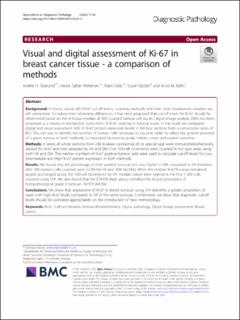| dc.contributor.author | Skjervold, Anette Hansen | |
| dc.contributor.author | Pettersen, Henrik P Sahlin | |
| dc.contributor.author | Valla, Marit | |
| dc.contributor.author | Opdahl, Signe | |
| dc.contributor.author | Bofin, Anna Mary | |
| dc.date.accessioned | 2023-01-31T09:59:33Z | |
| dc.date.available | 2023-01-31T09:59:33Z | |
| dc.date.created | 2022-05-11T08:52:13Z | |
| dc.date.issued | 2022 | |
| dc.identifier.issn | 1746-1596 | |
| dc.identifier.uri | https://hdl.handle.net/11250/3047308 | |
| dc.description.abstract | Background
In breast cancer (BC) Ki-67 cut-off levels, counting methods and inter- and intraobserver variation are still unresolved. To reduce inter-laboratory differences, it has been proposed that cut-off levels for Ki-67 should be determined based on the in-house median of 500 counted tumour cell nuclei. Digital image analysis (DIA) has been proposed as a means to standardize assessment of Ki-67 staining in tumour tissue. In this study we compared digital and visual assessment (VA) of Ki-67 protein expression levels in full-face sections from a consecutive series of BCs. The aim was to identify the number of tumour cells necessary to count in order to reflect the growth potential of a given tumour in both methods, as measured by tumour grade, mitotic count and patient outcome.
Methods
A series of whole sections from 248 invasive carcinomas of no special type were immunohistochemically stained for Ki-67 and then assessed by VA and DIA. Five 100-cell increments were counted in hot spot areas using both VA and DIA. The median numbers of Ki-67 positive tumour cells were used to calculate cut-off levels for Low, Intermediate and High Ki-67 protein expression in both methods.
Results
We found that the percentage of Ki-67 positive tumour cells was higher in DIA compared to VA (medians after 500 tumour cells counted were 22.3% for VA and 30% for DIA). While the median Ki-67% values remained largely unchanged across the 100-cell increments for VA, median values were highest in the first 1-200 cells counted using DIA. We also found that the DIA100 High group identified the largest proportion of histopathological grade 3 tumours 70/101 (69.3%).
Conclusions
We show that assessment of Ki-67 in breast tumours using DIA identifies a greater proportion of cases with high Ki-67 levels compared to VA of the same tumours. Furthermore, we show that diagnostic cut-off levels should be calibrated appropriately on the introduction of new methodology. | en_US |
| dc.language.iso | eng | en_US |
| dc.publisher | BioMed Central | en_US |
| dc.rights | Navngivelse 4.0 Internasjonal | * |
| dc.rights.uri | http://creativecommons.org/licenses/by/4.0/deed.no | * |
| dc.title | Visual and digital assessment of Ki-67 in breast cancer tissue - a comparison of methods | en_US |
| dc.title.alternative | Visual and digital assessment of Ki-67 in breast cancer tissue - a comparison of methods | en_US |
| dc.type | Peer reviewed | en_US |
| dc.type | Journal article | en_US |
| dc.description.version | publishedVersion | en_US |
| dc.source.volume | 17 | en_US |
| dc.source.journal | Diagnostic Pathology | en_US |
| dc.source.issue | 1 | en_US |
| dc.identifier.doi | 10.1186/s13000-022-01225-4 | |
| dc.identifier.cristin | 2023285 | |
| dc.source.articlenumber | 45 | en_US |
| cristin.ispublished | true | |
| cristin.fulltext | original | |
| cristin.qualitycode | 1 | |

